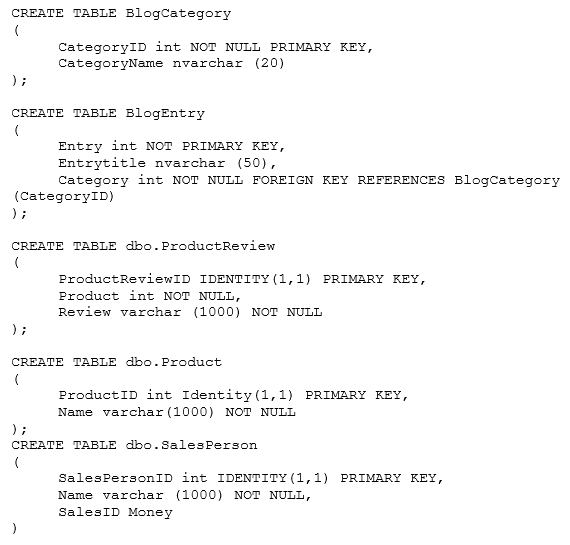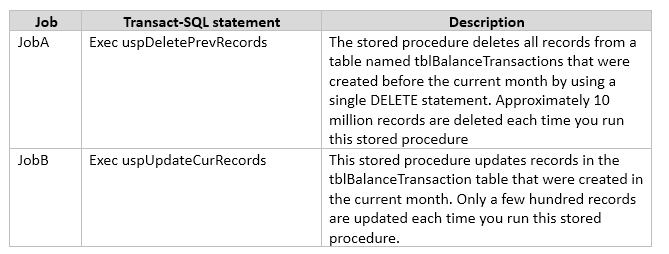File Info
| Exam | Developing SQL Databases |
| Number | 70-762 |
| File Name | Microsoft.70-762.CertKey.2020-05-06.103q.tqb |
| Size | 5 MB |
| Posted | May 06, 2020 |
| Download | Microsoft.70-762.CertKey.2020-05-06.103q.tqb |
How to open VCEX & EXAM Files?
Files with VCEX & EXAM extensions can be opened by ProfExam Simulator.
Coupon: MASTEREXAM
With discount: 20%





Demo Questions
Question 1

Note: This question is part of a series of questions that use the same scenario. For your convenience, the scenario is repeated in each question. Each question presents a different goal and answer choices, but the text of the scenario is exactly the same in each question in this series.
You have a database that contains the following tables: BlogCategory, BlogEntry, ProductReview, Product, and SalesPerson. The tables were created using the following Transact SQL statements:

You must modify the ProductReview Table to meet the following requirements:
- The table must reference the ProductID column in the Product table
- Existing records in the ProductReview table must not be validated with the Product table.
- Deleting records in the Product table must not be allowed if records are referenced by the ProductReview table.
- Changes to records in the Product table must propagate to the ProductReview table.
You also have the following databse tables: Order, ProductTypes, and SalesHistory, The transact-SQL statements for these tables are not available.
You must modify the Orders table to meet the following requirements:
- Create new rows in the table without granting INSERT permissions to the table.
- Notify the sales person who places an order whether or not the order was completed.
You must add the following constraints to the SalesHistory table:
- a constraint on the SaleID column that allows the field to be used as a record identifier
- a constant that uses the ProductID column to reference the Product column of the ProductTypes table
- a constraint on the CategoryID column that allows one row with a null value in the column
- a constraint that limits the SalePrice column to values greater than four
Finance department users must be able to retrieve data from the SalesHistory table for sales persons where the value of the SalesYTD column is above a certain threshold.
You plan to create a memory-optimized table named SalesOrder. The table must meet the following requirments:
- The table must hold 10 million unique sales orders.
- The table must use checkpoints to minimize I/O operations and must not use transaction logging.
- Data loss is acceptable.
Performance for queries against the SalesOrder table that use Where clauses with exact equality operations must be optimized.
You need to modify the design of the Orders table.
What should you create?
- a stored procedure with the RETURN statement
- a FOR UPDATE trigger
- an AFTER UPDATE trigger
- a user defined function
Correct answer: D
Explanation:
Requirements: You must modify the Orders table to meet the following requirements:Create new rows in the table without granting INSERT permissions to the table. Notify the sales person who places an order whether or not the order was completed. References:https://msdn.microsoft.com/en-us/library/ms186755.aspx Requirements: You must modify the Orders table to meet the following requirements:
- Create new rows in the table without granting INSERT permissions to the table.
- Notify the sales person who places an order whether or not the order was completed.
References:https://msdn.microsoft.com/en-us/library/ms186755.aspx
Question 2
You have a database that is experiencing deadlock issues when users run queries.
You need to ensure that all deadlocks are recorded in XML format.
What should you do?
- Create a Microsoft SQL Server Integration Services package that uses sys.dm_tran_locks.
- Enable trace flag 1224 by using the Database Cpmsistency Checker(BDCC).
- Enable trace flag 1222 in the startup options for Microsoft SQL Server.
- Use the Microsoft SQL Server Profiler Lock:Deadlock event class.
Correct answer: C
Explanation:
When deadlocks occur, trace flag 1204 and trace flag 1222 return information that is capturedin the SQL Server error log. Trace flag 1204 reports deadlock information formatted by each node involved in the deadlock. Trace flag 1222 formats deadlock information, first by processes and then by resources. The output format for Trace Flag 1222 only returns information in an XML-like format. References:https://technet.microsoft.com/en-us/library/ms178104(v=sql.105).aspx When deadlocks occur, trace flag 1204 and trace flag 1222 return information that is capturedin the SQL Server error log. Trace flag 1204 reports deadlock information formatted by each node involved in the deadlock. Trace flag 1222 formats deadlock information, first by processes and then by resources.
The output format for Trace Flag 1222 only returns information in an XML-like format.
References:
https://technet.microsoft.com/en-us/library/ms178104(v=sql.105).aspx
Question 3

You are developing an application that connects to a database.
The application runs the following jobs:

The READ_COMMITTED_SNAPSHOT database option is set to OFF, and auto-content is set to ON. Within the stored procedures, no explicit transactions are defined.
If JobB starts before JobA, it can finish in seconds. If JobA starts first, JobB takes a long time to complete.
You need to use Microsoft SQL Server Profiler to determine whether the blocking that you observe in JobB is caused by locks acquired by JobA.
Which trace event class in the Locks event category should you use?
- LockAcquired
- LockCancel
- LockDeadlock
- LockEscalation
Correct answer: A
Explanation:
The Lock:Acquiredevent class indicates that acquisition of a lock on a resource, such asa data page, has been achieved.The Lock:Acquired and Lock:Released event classes can be used to monitor when objects are being locked, the type of locks taken, and for how long the locks were retained. Locks retained for long periods of time may cause contention issues and should be investigated. The Lock:Acquiredevent class indicates that acquisition of a lock on a resource, such asa data page, has been achieved.
The Lock:Acquired and Lock:Released event classes can be used to monitor when objects are being locked, the type of locks taken, and for how long the locks were retained. Locks retained for long periods of time may cause contention issues and should be investigated.

